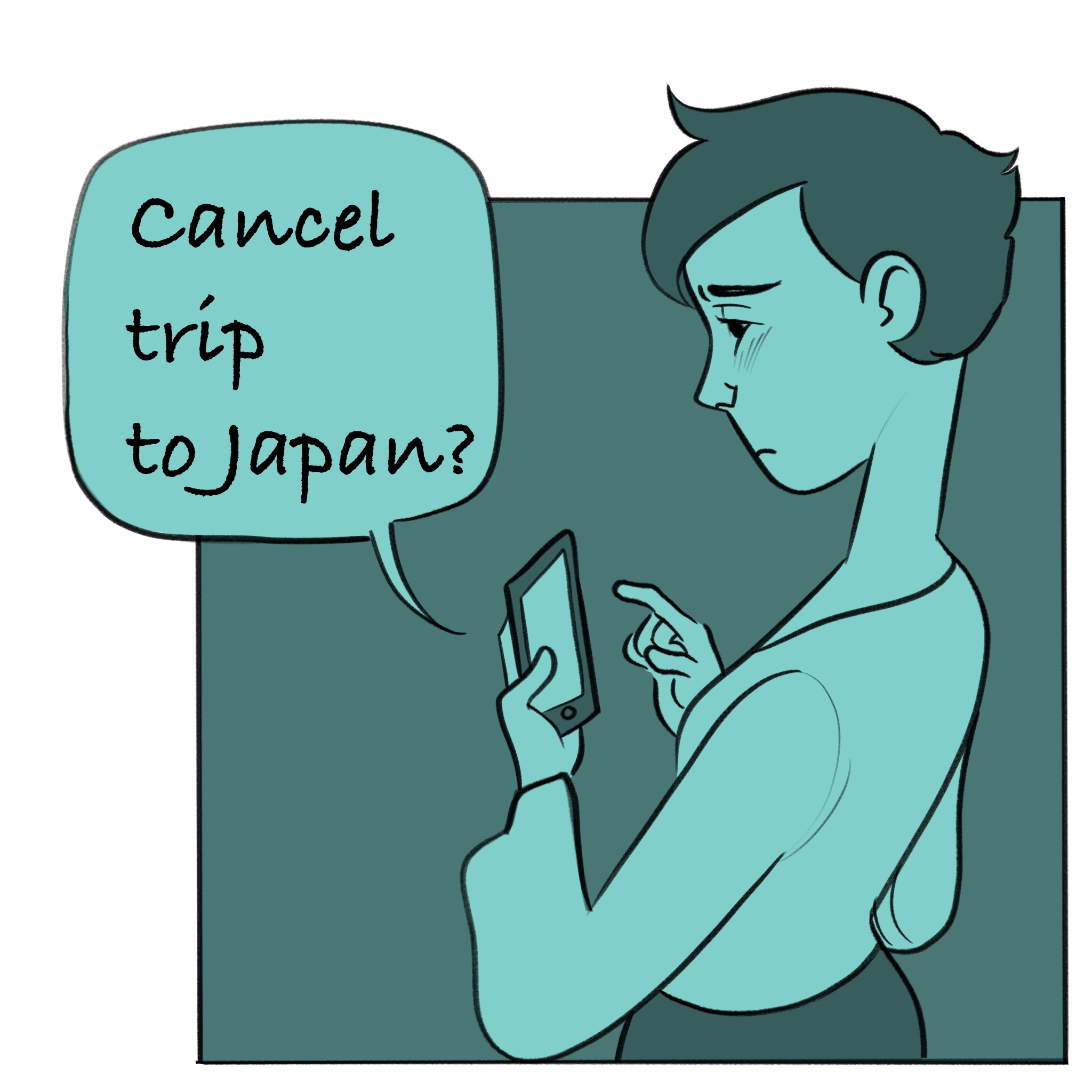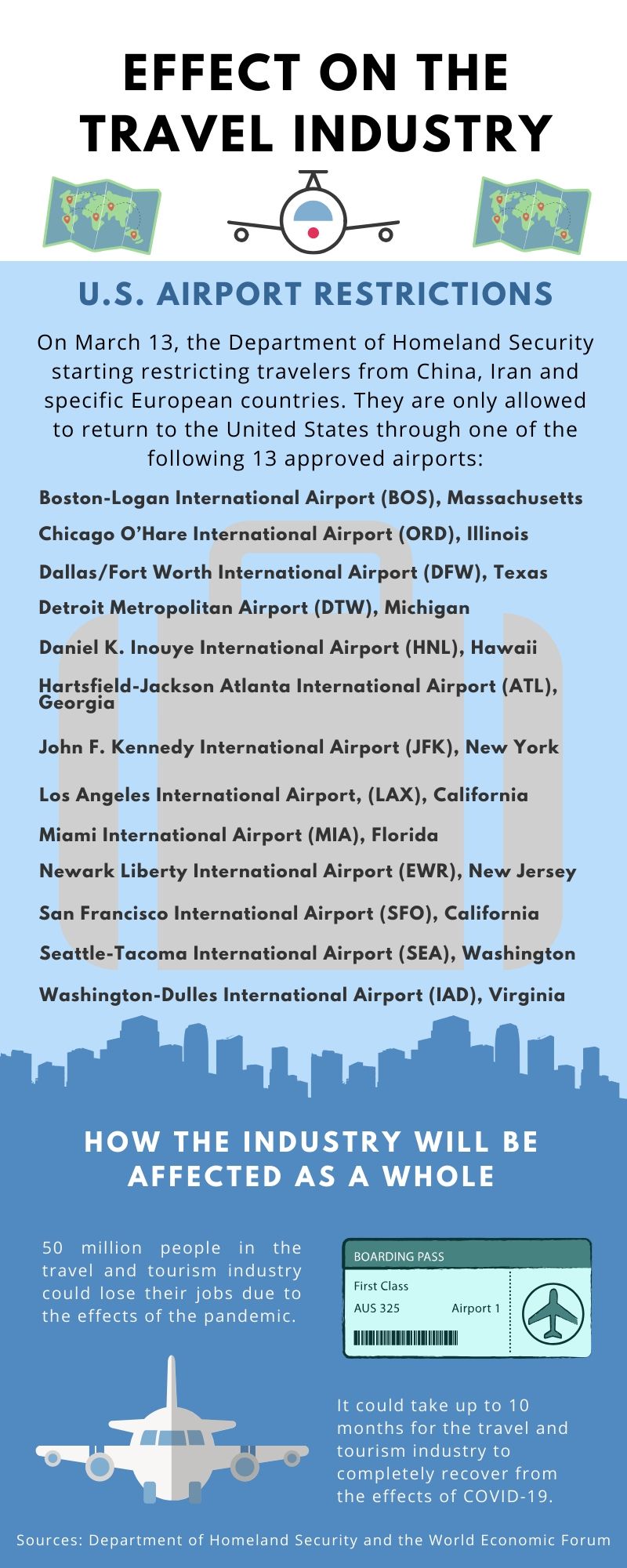

On March 13, President Trump enacted a travel ban on 28 European countries, causing many international airlines to cancel European routes to and from the US, heavily impacting the travel industry. Airlines, cruise ship companies, local museums and national parks scrambled to find solutions to cope with these setbacks during the crisis.
“[San Francisco International Airport] is very quiet because of the reduced flights and fewer passengers,” said Doug Yakel, the Public Information Officer at SFO. “There’s little to no waiting wherever you go. We know this is a stressful time for travelers, so our goal is to provide as much information and support as we can.”
A report from Airports Council International estimates that the number of passengers in U.S. airports from March to June will decrease by 73%, meaning airports will lose 244 million travelers in the first half of 2020. Additionally, the total airport operating revenue will drop by $12.3 billion, about a 49% reduction. All airports are also under heavy burden to repay debts, as those will continue despite the sharp cut on their revenues. Airport debts come from construction projects, such as building a terminal, which are funded by Airport General Revenue Bonds and slowly repaid back with interest over the years. In total, U.S. airports are expected to lose $13.9 billion this year.
“I think there’s a lot of worry and stress about our job,” said Jessica Davis*, who works at one of America’s main airlines. “We don’t know what’s going to happen, every day is a new day with new decisions and new laws. I don’t know if I’m going to keep my job by the end of the year and I don’t know if airlines are going to go bankrupt. So there’s a lot of uncertainty.”
Due to the travel ban, U.S. citizens traveling from restricted countries can only return home through 13 airports across the U.S. These travelers go through a health screening that checks for their temperature and asks them health-related questions.
As a result of the travel ban, airlines have sharply cut the number of international flights. For example, 40% of United Airlines’ operations are being cut. However, domestic flights are still continuing.
“Internationally wise, everything is frozen at this point until further notice,” Davis said. “For Google, Facebook and all those big Bay Area companies, businesses have to continue. So there is some travel back to the East Coast, like Denver or Houston or New York. We used to use big aircrafts like the [Boeing 777]. [Now] the company is reducing their aircraft [sizes]. It’s less fuel, less meals and also really cost efficient for the company.”
Furthermore, some airlines are flying ghost flights, planes with no or barely any passengers abroad, so they can keep their flight slots at the airport. Airlines are required to use their slots at least eighty percent of the time, so with the sudden decrease of travelers, they might risk losing the slot to a competitor.
Both San Francisco International and the airlines are doing thorough cleaning and disinfection of high-touch areas. For example, the cleaning team spends 30 minutes cleaning each plane before the plane is dispatched to another destination. The San Francisco Airport also installed 350 hand sanitizer stations.
“I’m trying to keep it as normal as possible just because I’m not one to panic anyway,” Davis said. “Everyone is so aware. We’re not hugging each other like we used to or giving high fives. The passengers are very aware too. They themselves are covered.”
The travel ban has also caused some students to cancel their spring break and even summer vacations.
“The travel ban impacts students who were going to leave the country, although I don’t know anyone who was planning to for spring break since it’s only a week long,” said junior Aretha Chen. “However … some of [my friends] have expressed concern for their summer plans being canceled if the travel ban is extended. Hopefully the situation will be better by then and there will be no need for that.”
The coronavirus pandemic seems to have put a restriction to traveling in general.
“My family and I were planning on taking a long weekend trip and driving somewhere like Napa or Carmel,” said freshman Jane Palladino. “[But] we probably aren’t going now because of how fast [the virus] is spreading.”
Despite the travel ban disrupting student’s spring break plans, Lee thinks safety is first priority.
“I believe that these travel restrictions are ultimately necessary to preserve public safety, and I’m completely willing to give up traveling for that,” Lee said. “I like to think that by staying home and not spreading the virus, I’m helping save lives, which is far more rewarding than any trip to Italy could ever be.”

Although the travel ban may minimize the spread of the virus, freshman Deirdre Doyle views it in a negative light.
“I think there are also political motives behind [the travel ban] that I do not approve of or appreciate,” Doyle said. “I’m worried all these bans and political actions made on the basis of safety are only going to separate our world more than it already is when what we need to be doing is coming together as a whole and finding a way to look past personal motives and see the bigger picture.”
Davis also has concerns that the travel ban will restrict emergency visits to family living in Europe.
My [whole] family is in France … and fortunately for us, no one is sick or needs assistance,” Davis said. “But if we had an emergency, if I had to go see my family of elderly parents, then I can’t go.”
Additionally, most local museums and national parks have closed in response to the coronavirus. The De Young Museum has been closed since March 14, but along with the other museums within the Fine Arts Museums, it is preparing new digital content to share with the public as soon as possible.
“During times of crisis, I am reminded of the importance of art to connect us,” said Shaquille Heath, Manager of Communications at the Fine Arts Museums of San Francisco. “It makes me feel more passionate about my work and ensuring access to art for all.
In the past month, a 71-year-old passenger of the Grand Princess Cruise ship that departed from San Francisco died of coronavirus after returning home for 10 days. Moreover, there are currently a total of 103 passengers that have tested positive for the virus.
Originally, an estimated 32 million people were expected to board ocean cruises in 2020. However, with more than 800 passengers infected from the Grand Princess Cruise ship and Diamond Princess Cruise ship in Japan, the CDC has stated that people should avoid traveling in cruise ships during this pandemic. Furthermore, Carnival Cruise Lines, Holland America, Princess Cruises and more are all suspended until the end of June.
“We’re in the midst of an outbreak that highlights just how connected our world is these days,” Yakel said. “While the measures being taken have an impact on our airport, these are very important steps to reduce the further spread of this disease.”
For now, it is unclear when the usual flights and business hours of museums and tourist attractions can resume. The travel industry has no other option but to wait for the pandemic to end before returning back to full operation.
*Jessica Davis is a fake name
